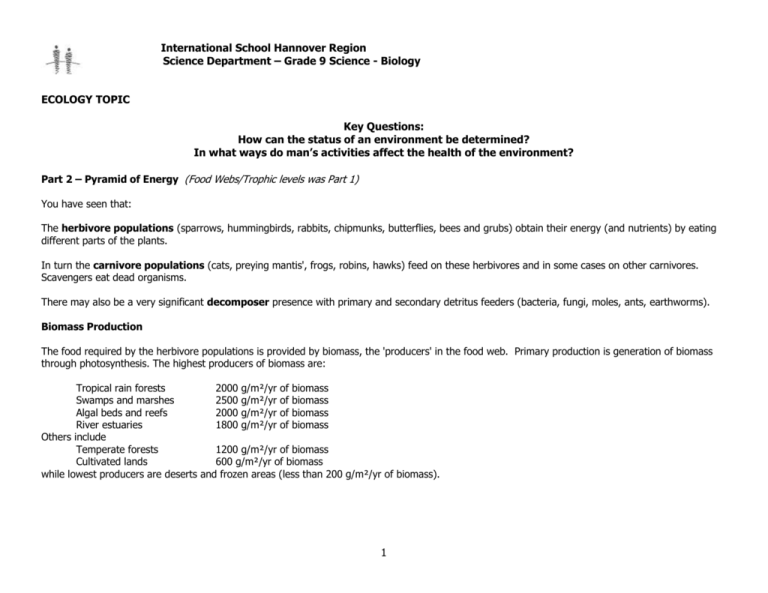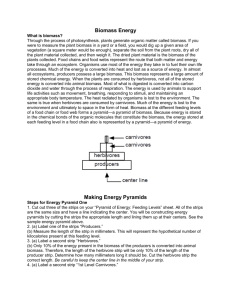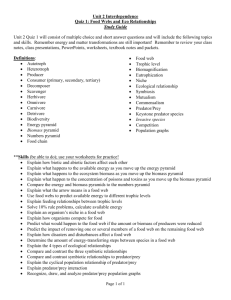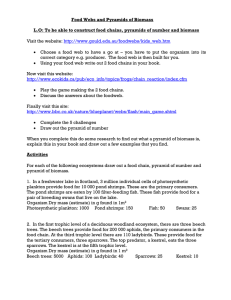international School Hannover Region - ISHR-G9
advertisement

International School Hannover Region Science Department – Grade 9 Science - Biology ECOLOGY TOPIC Key Questions: How can the status of an environment be determined? In what ways do man’s activities affect the health of the environment? Part 2 – Pyramid of Energy (Food Webs/Trophic levels was Part 1) You have seen that: The herbivore populations (sparrows, hummingbirds, rabbits, chipmunks, butterflies, bees and grubs) obtain their energy (and nutrients) by eating different parts of the plants. In turn the carnivore populations (cats, preying mantis', frogs, robins, hawks) feed on these herbivores and in some cases on other carnivores. Scavengers eat dead organisms. There may also be a very significant decomposer presence with primary and secondary detritus feeders (bacteria, fungi, moles, ants, earthworms). Biomass Production The food required by the herbivore populations is provided by biomass, the 'producers' in the food web. Primary production is generation of biomass through photosynthesis. The highest producers of biomass are: Tropical rain forests 2000 g/m²/yr of biomass Swamps and marshes 2500 g/m²/yr of biomass Algal beds and reefs 2000 g/m²/yr of biomass River estuaries 1800 g/m²/yr of biomass Others include Temperate forests 1200 g/m²/yr of biomass Cultivated lands 600 g/m²/yr of biomass while lowest producers are deserts and frozen areas (less than 200 g/m²/yr of biomass). 1 Creating Pyramids of Energy TASK 1 Here is a simple method of demonstrating the energy transformations in an ecosystem using a pyramid. Complete this exercise Steps for Energy Pyramid One – general method 1. Cut out each of the strips on your “Pyramid of Energy: Feeding levels” sheet on page 6. The strips are the same size and have a line in the middle to show you where the centre of the strip is. You create the pyramid by cutting the strips to the correct length and then lining them up at their centers. 2. Label one strip “Producers” Measure the length of this strip in millimeters and record this number in the Pyramid of Energy data table. This will represent the hypothetical number of kilocalories present at this feeding level. 3. Label a second strip “Primary Consumers” Only 10% of the energy present in the biomass of the producers is converted into animal biomass. Therefore the length of the Primary Consumer strip can only be 10% of the length of the Producer strip. Determine how many millimeters that is, write it in your table and then cut the strip. Keep the centre line in the CENTRE of the strip. 4. Label a third strip “Secondary consumers” Only 10% of the energy present in the biomass of the Primary consumers is transferred to the secondary consumers. Therefore the length of this third strip must be 10% of the second one. Determine this amount, write it down in your table and cut the strip. Keep the centre line in the CENTRE of the strip. 5. Determine how long the strip would be for Tertiary consumers, record this in your table, but do not cut a strip. 6. Arrange the three strips in a pyramid with the centre lines aligned in the middle of the pyramid. Glue them to your paper and label this diagram “Energy Pyramid One” This first pyramid is a generalized Energy pyramid to illustrate the method. Now create two more specific pyramids. TASK 2 One for a Temperate forest and TASK 3 another for a Coniferous forest using the following information on page 3. 2 Temperate & Coniferous Forests A temperate forest, like the Eilenreide produces approximately 8,000 kilocalories per square meter per year (written 8,000 kcal/m2/year = 33,600 kJ/m2/yr (1 calorie = 4.2 joules)). It consists mainly of deciduous trees that lose there leaves each year. A coniferous forest populated with trees that do not lose their leaves in the winter produces less biomass, only about 3,000 kcal/m2/year. (How many Joules is that?) 1. Use the data table on the next page to calculate energy present in each level 2. Using a scale that 10 millimeters equals 400 kcal make an energy pyramid that represents the amount of energy captured by one square meter of temperate deciduous forest in a year and another that represents the amount of energy captured in a year by one square meter of coniferous forest. 3. First record the length of the strips that you need and the kilogram calories each represents in the correct place in the table. Calculate also the amount of energy lost at each level. 4. Except for the scale, follow the steps 1-6 above. Tape or glue each completed energy pyramid to your paper and label it with the correct title. Note: if some of the strips are too small to cut, use a pencil to draw that section of the pyramid. l 3 Pyramids of Energy Pyramid One Energy present Length of strip (mm) (kilocalories) Energy lost as heat (kiloalories) Producers 240 240 Primary Consumers 24 24 Energy present (kcal) Length of strip (mm) Energy lost as heat (kcal) Energy present (kcal) Length of strip (mm) Energy lost as heat (kical) 216.0 Secondary Consumers Tertiary Consumers Temperate Forest Energy Pyramid Producers Primary Consumers Secondary Consumers Tertiary Consumers Coniferous Forest Energy Pyramid Producers Primary Consumers Secondary Consumers Tertiary Consumers 4 TASK 4 Conclusion/Analysis (Use your own paper to answer these questions) 1. Explain what has happened to the energy that is not transferred at each feeding level. 2. Explain why the energy that is not transferred at each level can not be picked up by plants and cycled back though the system the way molecules are cycled. 3. The first law of thermodynamics states that energy can neither be destroyed nor created. The second law of thermodynamics states that in every energy conversion, some energy is lost as heat. Explain how these laws relate to the functioning of an ecosystem. 4. If 1000 kg of plant material are consumed by the rabbit population of an area explain why a few days later the rabbit population does not weigh 1000 kg more than it did. Here is a typical pyramid: Image from: http://kentsimmons.uwinnipeg.ca/16cm05/1116/16ecosys.htm Incidence of solar power at surface, temperate, mid-day ~ 1000 Watts/m2 = 1000 Joules/second/ on each m2 ~ 250 cal/sec on each m2 ~ 8,000,000 kcal/year on each m2 1% of this is 80,000 kcal/yr/m2, so trees which produce 8,000 kcal/yr/m 2 are converting about 0.1% of the solar energy landing on that ground. 5 Pyramid of Energy: Feeding Levels This material is edited from open source material at: http://www.bbc.co.uk/schools/gcsebitesize/science/aqa/human/ http://en.wikipedia.org/wiki/Ecology, with reference also to: Science World Book 2, Stannard & Williamson. 6 AW







